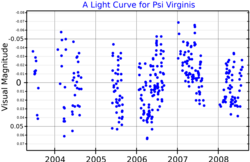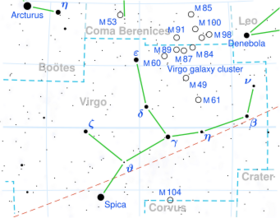Astronomy:Psi Virginis
| Observation data Equinox J2000.0]] (ICRS) | |
|---|---|
| Constellation | Virgo |
| Right ascension | 12h 54m 21.16342s[1] |
| Declination | −09° 32′ 20.3783″[1] |
| Apparent magnitude (V) | 4.73 - 4.96[2] |
| Characteristics | |
| Spectral type | M3 IIICa-1[3] |
| U−B color index | +1.57[4] |
| B−V color index | +1.58[4] |
| Variable type | LB[2] |
| Astrometry | |
| Radial velocity (Rv) | +12.82[5] km/s |
| Proper motion (μ) | RA: −18.08[1] mas/yr Dec.: −19.52[1] mas/yr |
| Parallax (π) | 5.99 ± 0.23[1] mas |
| Distance | 540 ± 20 ly (167 ± 6 pc) |
| Absolute magnitude (MV) | −1.34[6] |
| Details | |
| Mass | 3.95[7] M☉ |
| Radius | 93[8] R☉ |
| Luminosity | 3,548[7] L☉ |
| Surface gravity (log g) | 1.05[9] cgs |
| Temperature | 3,500[7] K |
| Metallicity [Fe/H] | −0.10[9] dex |
| Other designations | |
| Database references | |
| SIMBAD | data |
Psi Virginis (ψ Vir, ψ Virginis) is a suspected[5] binary star[3] system in the zodiac constellation of Virgo. It can be seen with the naked eye and has an apparent visual magnitude of about 4.8. Based upon the annual parallax shift of 5.99 milliarcseconds, the distance to this star is roughly 540 light years. The angular size of Psi Virginis was measured on December 26, 1975 during an occultation by the Moon, yielding the estimate 6.5±0.3 mas.[11]

The primary component is an evolved red giant star with a stellar classification of M3 IIICa-1.[3] It is an irregular variable[13] with seven measured pulsation periods ranging from 22.4 to 162.6 days, and amplitudes ranging up to 0.m022.[12] The star is a bright X-ray source with a luminosity of 21.58×1029 ergs s−1.[14] There is a magnitude 8.3 companion at an angular separation of 0.04 arcseconds.[3]
References
- ↑ 1.0 1.1 1.2 1.3 1.4 van Leeuwen, F. (November 2007), "Validation of the new Hipparcos reduction", Astronomy and Astrophysics 474 (2): 653–664, doi:10.1051/0004-6361:20078357, Bibcode: 2007A&A...474..653V.
- ↑ 2.0 2.1 Samus', N. N.; Kazarovets, E. V.; Durlevich, O. V.; Kireeva, N. N.; Pastukhova, E. N. (2017), "General catalogue of variable stars: Version GCVS 5.1", Astronomy Reports 61 (1): 80, doi:10.1134/S1063772917010085, Bibcode: 2017ARep...61...80S.
- ↑ 3.0 3.1 3.2 3.3 Eggleton, P. P.; Tokovinin, A. A. (September 2008), "A catalogue of multiplicity among bright stellar systems", Monthly Notices of the Royal Astronomical Society 389 (2): 869–879, doi:10.1111/j.1365-2966.2008.13596.x, Bibcode: 2008MNRAS.389..869E.
- ↑ 4.0 4.1 Mermilliod, J.-C. (1986), "Compilation of Eggen's UBV data, transformed to UBV (unpublished)", Catalogue of Eggen's UBV Data (SIMBAD), Bibcode: 1986EgUBV........0M
- ↑ 5.0 5.1 Famaey, B. et al. (2009), "Spectroscopic binaries among Hipparcos M giants. I. Data, orbits, and intrinsic variations", Astronomy and Astrophysics 498 (2): 627–640, doi:10.1051/0004-6361/200810698, Bibcode: 2009A&A...498..627F.
- ↑ Anderson, E.; Francis, Ch. (2012), "XHIP: An extended hipparcos compilation", Astronomy Letters 38 (5): 331, doi:10.1134/S1063773712050015, Bibcode: 2012AstL...38..331A.
- ↑ 7.0 7.1 7.2 Charbonnel, C.; Lagarde, N.; Jasniewicz, G.; North, P. L.; Shetrone, M.; Krugler Hollek, J.; Smith, V. V.; Smiljanic, R. et al. (2020), "Lithium in red giant stars: Constraining non-standard mixing with large surveys in the Gaia era", Astronomy and Astrophysics 633: A34, doi:10.1051/0004-6361/201936360, Bibcode: 2020A&A...633A..34C.
- ↑ Stassun K.G. (October 2019), "The revised TESS Input Catalog and Candidate Target List", The Astronomical Journal 158 (4): 138, doi:10.3847/1538-3881/ab3467, Bibcode: 2019AJ....158..138S.
- ↑ 9.0 9.1 Wu, Yue; Singh, H. P; Prugniel, P; Gupta, R; Koleva, M (2010), "Coudé-feed stellar spectral library – atmospheric parameters", Astronomy & Astrophysics 525: A71, doi:10.1051/0004-6361/201015014, Bibcode: 2011A&A...525A..71W.
- ↑ "psi Vir -- Long-period variable star", SIMBAD Astronomical Database (Centre de Données astronomiques de Strasbourg), http://simbad.u-strasbg.fr/simbad/sim-id?Ident=psi+Vir, retrieved 2016-09-19.
- ↑ Evans, D. S. et al. (October 1977), "Angular diameter of psi Vir (SAO 139033) and chi 1Ori (SAO 077705)", Astronomical Journal 82: 828–831, doi:10.1086/112134, Bibcode: 1977AJ.....82..828E.
- ↑ 12.0 12.1 Tabur, V.; Bedding, T. R. (2009), "Long-term photometry and periods for 261 nearby pulsating M giants", Monthly Notices of the Royal Astronomical Society 400 (4): 1945–61, doi:10.1111/j.1365-2966.2009.15588.x, Bibcode: 2009MNRAS.400.1945T.
- ↑ Mennessier, M. O. et al. (August 2001), "Long period variable stars: galactic populations and infrared luminosity calibrations", Astronomy and Astrophysics 374 (3): 968–979, doi:10.1051/0004-6361:20010764, Bibcode: 2001A&A...374..968M.
- ↑ Makarov, Valeri V. (October 2003), "The 100 Brightest X-Ray Stars within 50 Parsecs of the Sun", The Astronomical Journal 126 (4): 1996–2008, doi:10.1086/378164, Bibcode: 2003AJ....126.1996M.
 |


